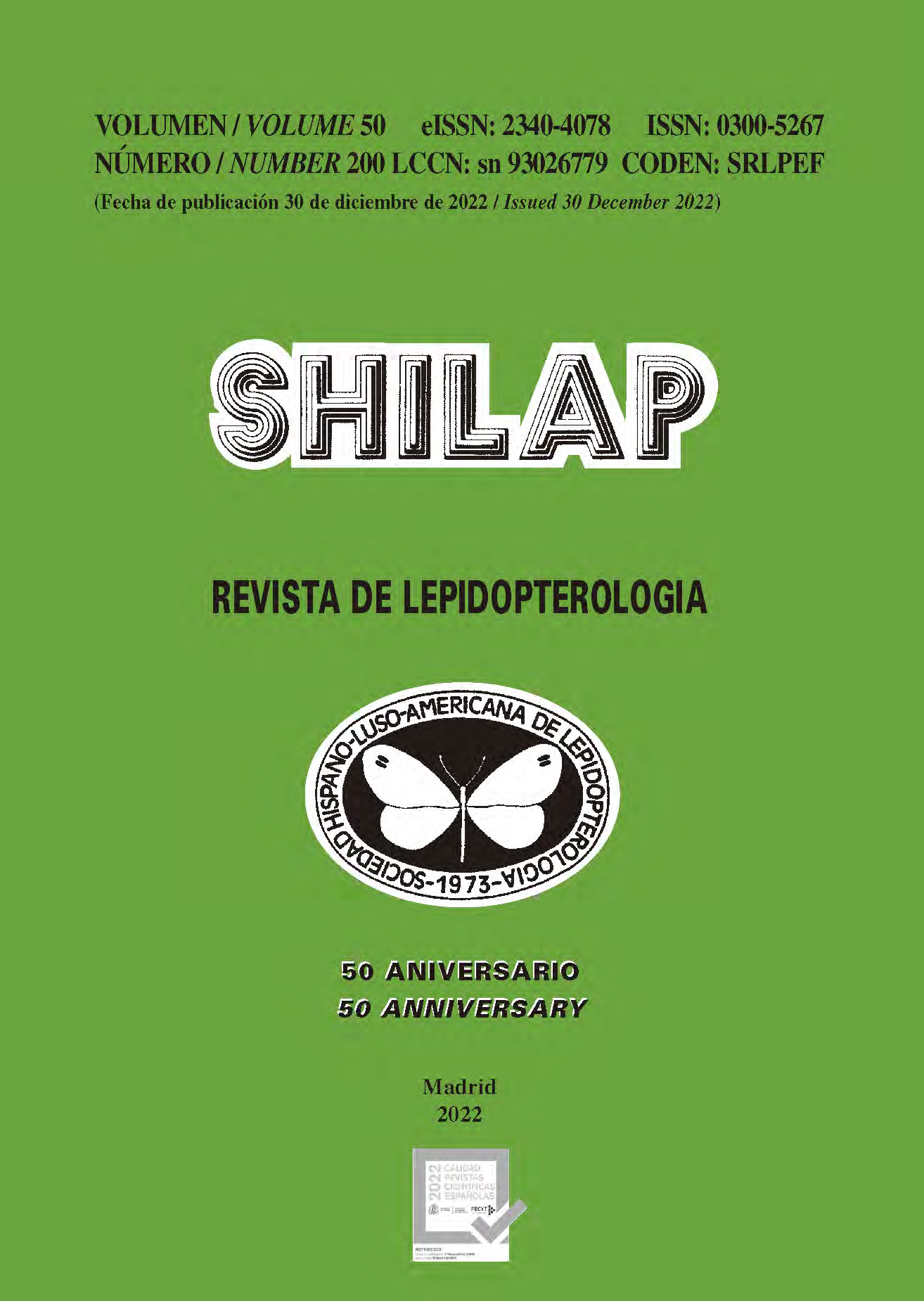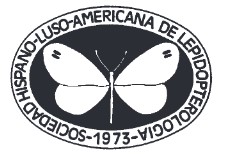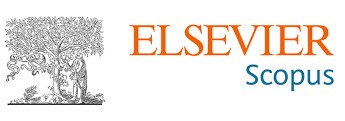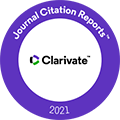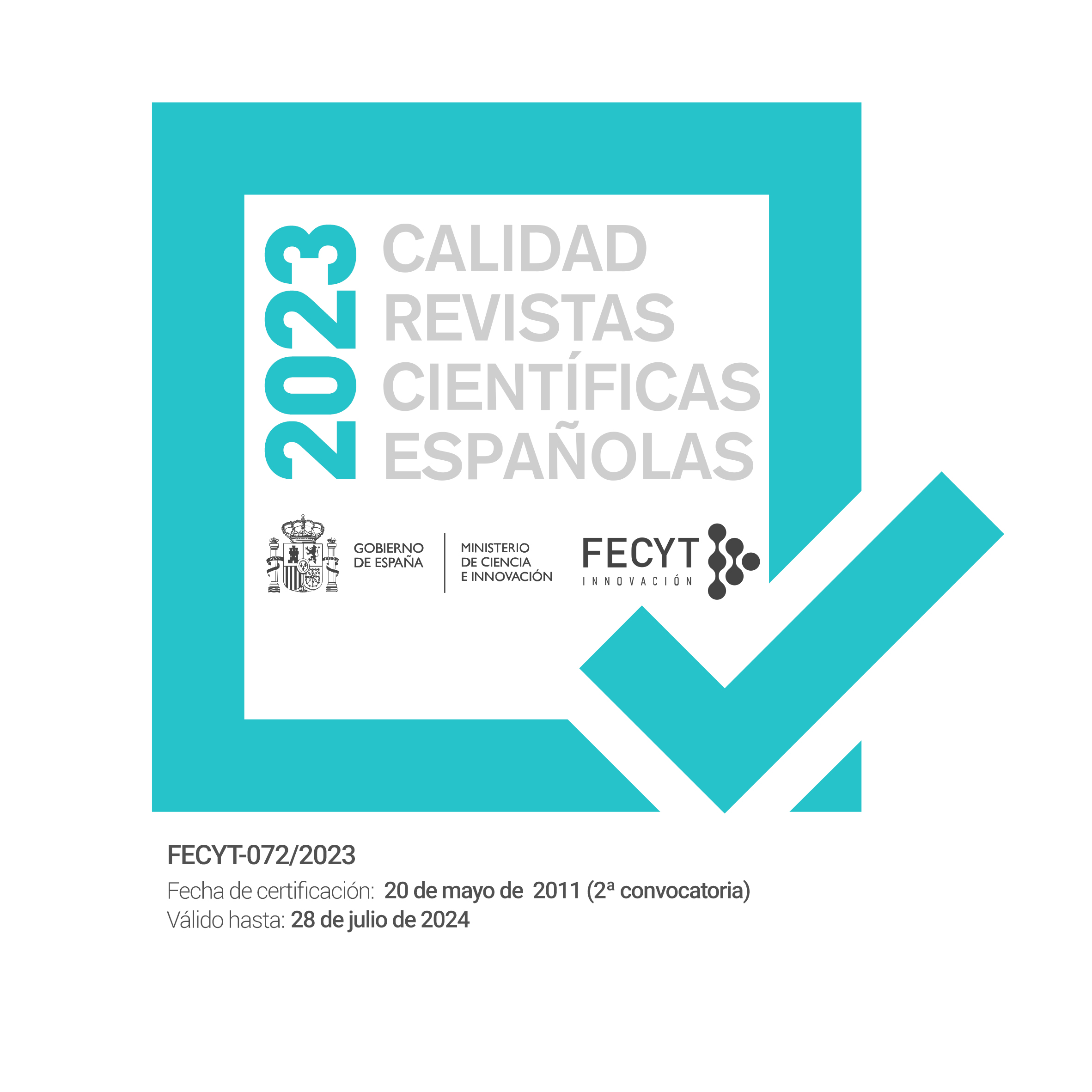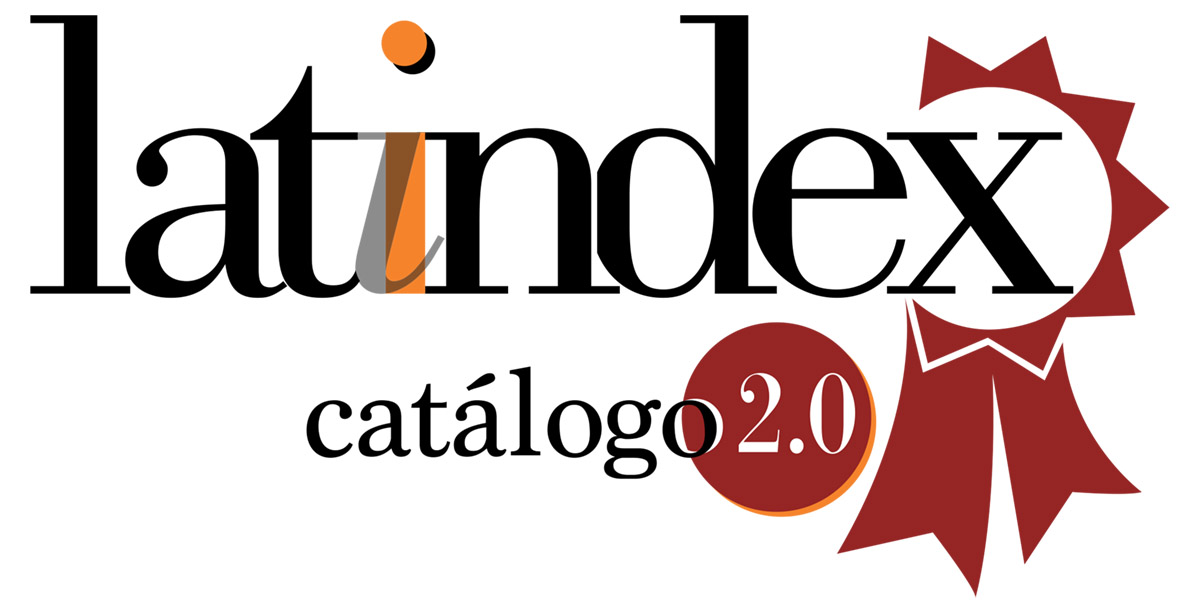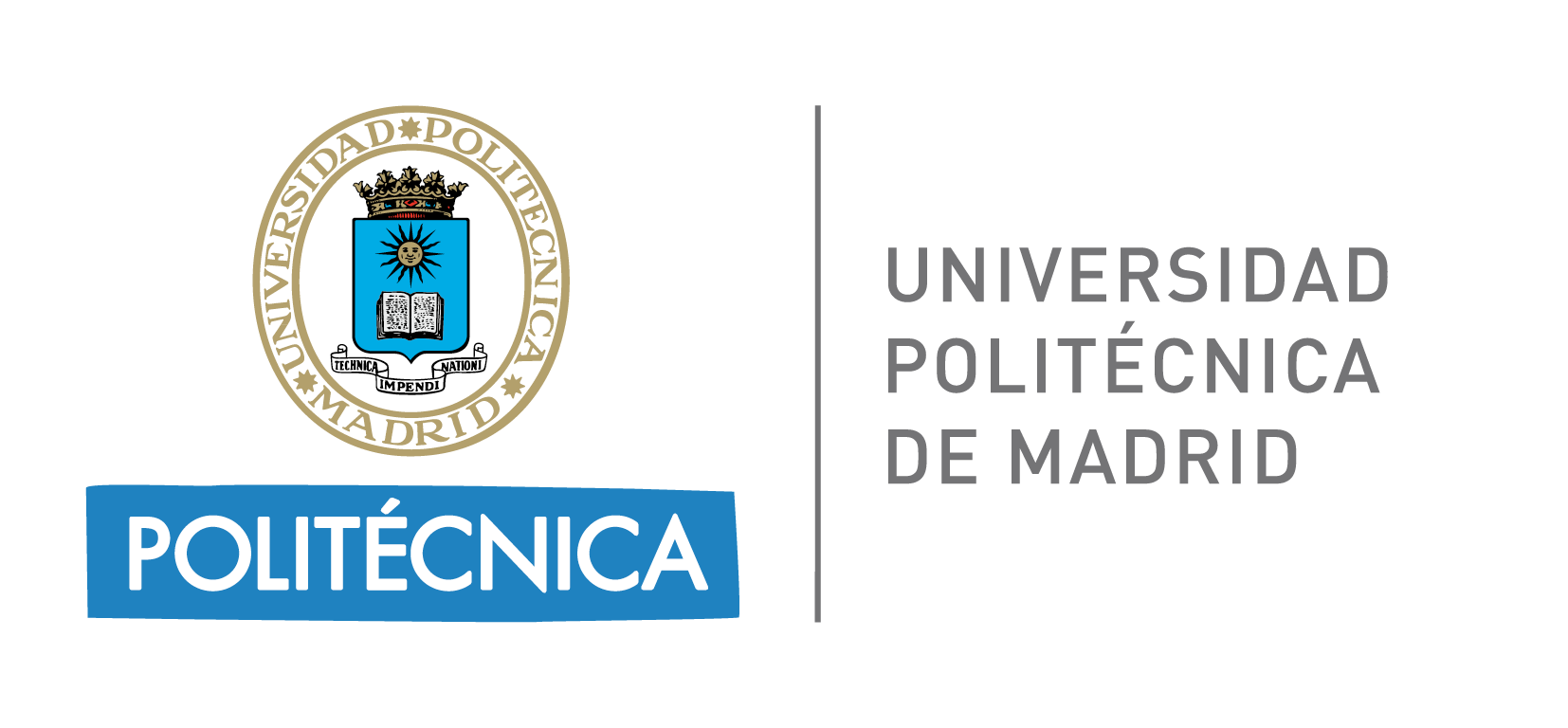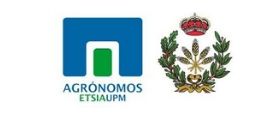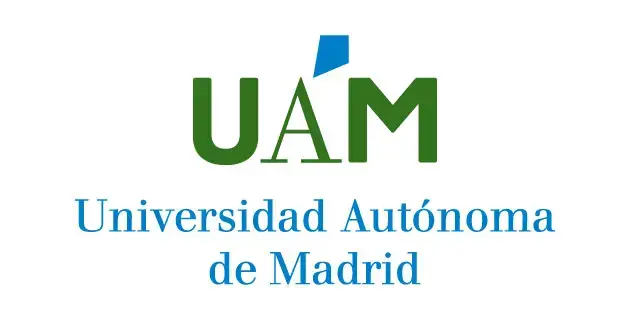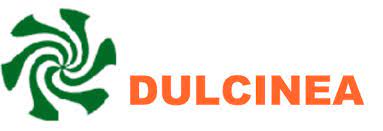Adult population fluctuation of Comadia redtenbacheri (Hammerschmidt, 1847) (Lepidoptera: Cossidae)
DOI:
https://doi.org/10.57065/shilap.265Keywords:
Lepidoptera, Cossidae, Comadia, ultraviolet light, trapping, MexicoAbstract
Comadia redtenbacheri (Hammerschmidt, 1847) is an insect highly regarded for its commercial and nutritional value. Adult fluctuation in a plantation of Agave salmiana Otto ex Salm-Dyck was determined using ultraviolet light traps. Trapped adults were counted weekly during three periods (December 2013 to December 2014, December 2014 to December 2015, and December 2015 to June 2016), and temperature and relative humidity were recorded. Adult population was present 157 days on average, from December to May, with peak capture on day 83. The average sex ratio of females to males was 1:14. Average environmental conditions that favoured the highest capture in the three periods were 17.8º C and 47.1% relative humidity. Knowledge of the period of adult presence and the influence of temperature and relative humidity are important for management and conservation of the insect population by farmers and gatherers.
Downloads
Global Statistics ℹ️
|
435
Views
|
339
Downloads
|
|
774
Total
|
|
References
Al-Deeb, M. A., Mahmoud, S. T., & Sharif, E. M. (2012). Use of light traps and differing light colour to investigate seasonal abundance of the date palm pest, Oryctes agamemnon arabicus (Coleoptera: Scarabaeidae). Journal of Economic Entomology, 105(6), 2062-2067. DOI: https://doi.org/10.1603/EC12141
Ancona, L. H. (1931). Los chilocuiles o gusanitos de la sal de Oaxaca. Anales del Instituto de Biología de la Universidad Nacional Autónoma de México, 2(1), 265-277.
Brown, R. M. (1975). A revision of the North American Comadia (Cossidae). Journal of Research on the Lepidoptera, 14(4), 189-212. DOI: https://doi.org/10.5962/p.280586
Cárdenas-Aquino, M. R., Alarcón-Rodríguez, N. Rivas-Medrano M., González-Hernández, H., Vargas-Hernández, M., Sánchez-Arroyo, H., & Llanderal-Cázares, C. (2018). Molecular delineation of the agave red worm Comadia redtenbacheri (Lepidoptera: Cossidae). Zootaxa, 4375(3), 358-370. DOI: https://doi.org/10.11646/zootaxa.4375.3.4
Castro-Torres, R. E., & Llanderal-Cázares, C. (2015). Principales caracteres morfológicos para el reconocimiento de Comadia redtenbacheri Hammerschmidt (Lepidoptera: Cossidae). Entomología Mexicana, 2(6), 798-803.
Castro-Torres, R., & Llanderal-Cázares, C. (2016). Detailed morphology of all life stages of the agave red worm, Comadia redtenbacheri (Hammerschmidt) (Lepidoptera: Cossidae). Neotropical Entomology, 45(6), 698-711. DOI: https://doi.org/10.1007/s13744-016-0425-7
CONAGUA (2020). Información de Estaciones Climatológicas. Estación 15090. San Jerónimo Xonocahuacan, Tecámac, Estado de México, México. https://smn.conagua.gob.mx/tools/RESOURCES/Diarios/15022.txt
Delgado-Tejeda, I., Llanderal-Cázares, C., Miranda-Perkins, K., & De Los Santos-Posadas, H. M. (2017). Pupación, emergencia de adultos y oviposición de Comadia redtenbacheri (Lepidoptera: Cossidae) en vivero. Agrociencia, 51(4), 447-454.
Durán, J. M., Alvarado, M., González, M., Jiménez, N., Sánchez, A., & Serrano, A. (2004). Control del taladro amarillo, Zeuzera pyrina L. (Lepidoptera, Cossidae), en olivar mediante confusión sexual. Boletín de Sanidad Vegetal de Plagas, 30(2), 451-462.
Espinosa-García, N., Llanderal-Cázares, C., Miranda-Perkins, K., Vargas-Hernández, M., González-Hernández H., & Romero-Nápoles, J. (2018). Infestación inducida de gusano rojo Comadia redtenbacheri en Agave salmiana. Southwestwern Entomologist, 43(4), 1009-1019. DOI: https://doi.org/10.3958/059.043.0418
Frost, S. W. (1957). The Pennsylvania insect light trap. Journal of Economic Entomology, 50(3), 287-292. DOI: https://doi.org/10.1093/jee/50.3.287
Hernández-Flores, L., Llanderal-Cázares, C., Guzmán-Franco, A. W., & Aranda-Ocampo, S. (2015). Bacteria present in Comadia redtenbacheri larvae (Lepidoptera: Cossidae). Journal of Medical Entomology, 52(5), 1150-1158. DOI: https://doi.org/10.1093/jme/tjv099
Hernández-Livera, R. A., Llanderal-Cázares, C., Castillo-Márquez, L. E., Valdez-Carrasco, J., & Nieto-Hernández, R. (2005). Identificación de instares larvales de Comadia redtenbacheri (Hamm) (Lepidoptera: Cossidae). Agrociencia, 39(5), 539-544.
Hienton, T. E. (1974). Summary of investigations of electric insect traps. Technical Bulletin Nº 1498. Agricultural Research Service. United States Department of Agriculture. Washington, D. C.
Ismail, I. I., Abou-Zeid, N. A., & Abdallah, F. F. (1992). Population dynamics of the leopard moth, Zeuzera pyrina L., and its control on olive trees in Egypt. Journal of Plant Diseases and Protection, 99(5), 519-524.
Llanderal-Cázares, C., Nieto-Hernández, R., Almanza-Valenzuela, I., & Ortega-Álvarez, C. (2007). Biología y comportamiento de Comadia redtenbacheri (Hamm) (Lepidoptera: Cossidae). Entomología Mexicana, 6(1), 252-255.
Llanderal-Cázares, C., De Los Santos-Posadas, H. M., Almanza-Valenzuela, I., Nieto-Hernández, R., & Castillejos-Cruz, C. (2010). Establecimiento del gusano rojo de maguey en invernadero. Acta Zoológica Mexicana (n. s.), 26(1), 25-31. DOI: https://doi.org/10.21829/azm.2010.261677
Llanderal-Cázares, C., Castro-Torres, R., & Miranda-Perkins, K. (2017). Bionomics of Comadia redtenbacheri (Hammerschmidt, 1847) (Lepidoptera: Cossidae). SHILAP Revista de lepidopterología, 45(179), 373-383.
Miranda-Perkins, K., Llanderal-Cázares, C., De Los Santos-Posadas, H. M., Portillo- Martínez, L., & Vigueras-Guzmán, A. L. (2013). Comadia redtenbacheri (Lepidoptera: Cossidae) pupal development in the laboratory. Florida Entomologist, 96(4), 1424-1433. DOI: https://doi.org/10.1653/024.096.0422
Miranda-Perkins, K., Llanderal-Cázares, C., Cadena-Barajas, M., & López-Sauceda, J. (2016). Adult emergence and reproductive behavior of Comadia redtenbacheri in confinement. Southwestern Entomologist, 41(3), 657-665. DOI: https://doi.org/10.3958/059.041.0308
Nielsen, A. L., Holmstrom, K., Hamilton, G. C., Cambridge, J., & Ingerson-Mahar, J. (2013). Use of black light traps to monitor the abundance, spread, and flight behavior of Halyomorpha halys (Hemiptera: Pentatomidae). Journal of Economic Entomology, 106(3), 1495-1502. DOI: https://doi.org/10.1603/EC12472
Nolasco, M. A., Jiménez-Luna, J. E., & Camacho, A. D. (2002). Inducción a la pupación y colonización del gusano rojo del maguey Comadia redtenbacheri H. (Lepidoptera: Cossidae). Entomología Mexicana, 1, 125-130.
Ramamurthy, V. V., Akhtar, M. S., Patankar, N. V., Menon, P., Kumar, R. K., Singh, S., Ayri, S., Parveen, S., & Mittal, V. (2010). Efficiency of different light sources in light traps in monitoring insect diversity. Munis Entomology & Zoology, 5(1), 109-114.
Ramírez-Cruz, A., & Llanderal-Cázares, C. (2015). Morfología del sistema reproductor de la hembra de Comadia redtenbacheri (Hammerschmidt) (Lepidoptera: Cossidae). Acta Zoológica Mexicana (n. s.), 31(3), 431-455. DOI: https://doi.org/10.21829/azm.2015.3131044
Ramos-Elorduy, J. (2006). Threatened edible insects in Hidalgo, and some measures to preserve them. Journal of Ethnobiology and Ethnomedicine, 2(51), 1-10. DOI: https://doi.org/10.1186/1746-4269-2-51
Ramos-Elorduy, J., Pino-Moreno, J. M., Vázquez, A. I., Landero, I., Oliva-Rivera, H., & Camacho, V. H. M. (2011). Lepidoptera in Mexico: Geographic distribution, ethnicity, economic and nutritional importance for rural people. Journal of Ethnobiology and Ethnomedicine, 7, 2-22. DOI: https://doi.org/10.1186/1746-4269-7-2
SAS Institute (2015). Statistical Analysis System. Copyright© SAS Institute Inc., versión 9.4. Cary, North Carolina.
Sermsri, N., & Torasa, C. (2015). Solar energy-based insect pest trap. Procedia-Social and Behavioral Sciences, 197(1), 2548-2553. DOI: https://doi.org/10.1016/j.sbspro.2015.07.620
Shimoda, M., & Honda, K. (2013). Insect reactions to light and its applications to pest management. Applied Entomology and Zoology, 48(4), 413-421. DOI: https://doi.org/10.1007/s13355-013-0219-x
Solomon, J. D., & Neel, W. W. (1973). Mating behavior in the carpenterworm moth, Prionoxystus robiniae (Lepidoptera: Cossidae). Annals of the Entomological Society of America, 66(2), 312-314. DOI: https://doi.org/10.1093/aesa/66.2.312
Solomon, J. D. (1976). Sex ratio of the carpenterworm moth (Prionoxystus robiniae) (Lepidoptera: Cossidae). The Canadian Entomologist, 108(3), 317-318. DOI: https://doi.org/10.4039/Ent108317-3
Szentkirályi, F. (2002). Fifty-year-long insect survey in Hungary: T. Jermy’s contributions to light-trapping. Acta Zoologica Academiae Scientiarum Hungaricae, 48(1), 85-105.
Tamiru, A., Getu E, Jembere, B., & Bruce, T. (2012). Effect of temperature and relative humidity on the development and fecundity of Chilo partellus Swinhoe (Lepidoptera: Crambidae). Bulletin of Entomological Research, 102(1), 9-15. DOI: https://doi.org/10.1017/S0007485311000307
Thomas, D. B. (2008). Nontoxic antifreeze for insect traps. Entomological News, 119(4), 361-365. DOI: https://doi.org/10.3157/0013-872X-119.4.361
Triplehorn, C. A., & Johnson, N. F. (2005). Borror and Delong’s Introduction to the Study of Insects. Thomson Brooks/Cole.
Truman, E. H. (1974). Summary of investigations of electric insect traps. Agricultural Research Service. United State Department of Agriculture. Technical Bulletin 1498.
Truxa, C., & Fiedler, K. (2012). Attraction to light-from how far do moths (Lepidoptera) return to weak artificial sources of light? European Journal Entomology, 109(1), 77-84. DOI: https://doi.org/10.14411/eje.2012.010
Yen, A. L. (2012). Edible insects and management of country. Ecological Management & Restoration, 13(1), 97-99. DOI: https://doi.org/10.1111/j.1442-8903.2011.00623.x
Zada, H., Saljoqi, A. U. R., Farid, A., Ullah, F., & Alikhan, I. (2014). Influence of weather parameters on population dynamics of apple codling moth Cydia pomonella (Lepidoptera; Tortricidae) at Matta Swat valley. Sarhad Journal of Agriculture, 30(3), 351-356.
Zetina, D. A. H., Llanderal-Cázares, C., Ruíz-Cancino, E., & Khalaim, A. I. (2009). Registro para México de Lissonota fascipennis Townes (Hymenoptera: Ichneumonidae), como parasitoide del gusano rojo del maguey. Acta Zoológica Mexicana (n. s.), 25(3), 655-657. DOI: https://doi.org/10.21829/azm.2009.253667
Zetina, D. A., Llanderal, C., & Huerta, H. (2012). Acantholespesia texana: A new report for Mexico, as a parasitoid of Comadia redtenbacheri Hamm. Southwestern Entomologist, 37(2), 235-237. DOI: https://doi.org/10.3958/059.037.0217
Zetina, D. A., & Llanderal, C. (2014). Signs and symptoms in Comadia redtenbacheri Hamm. (Lepidoptera:
Cossidae) larvae affected by parasitoids. Southwestern Entomologist, 39(2), 285-290.
Published
How to Cite
Issue
Section
License
Copyright (c) 2022 Manuel Jiménez-Vásquez, Celina Llanderal-Cázares, Kalina Miranda-Perkins, Mateo Vargas-Hernández, Rosa María López-Romero, Manuel Campos-Figueroa

This work is licensed under a Creative Commons Attribution 4.0 International License.
The author SS retains his trademark and patent rights to any process or procedure within the article.
The author retains the right to share, distribute, perform and publicly communicate the article published in SHILAP Revista de lepidopterología, with initial acknowledgement of its publication in SHILAP Revista de lepidopterología.
The author retains the right to make a subsequent publication of his work, from using the article to publishing it in a book, provided that he indicates its initial publication in SHILAP Revista de lepidopterología.
Each submission to SHILAP Revista de lepidopterología must be accompanied by an acceptance of copyright and acknowledgement of authorship. By accepting them, authors retain copyright of their work and agree that the article, if accepted for publication by SHILAP Revista de lepidopterología, will be licensed for use and distribution under a "Creative Commons Attribution 4.0 International" (CC BY 4.0) licence that allows third parties to share and adapt the content for any purpose giving appropriate credit to the original work.
You may read here the basic information and the legal text of the license. The indication of the CC BY 4.0 License must be expressly stated in this way when necessary.
As of 2022, the content of the print and digital version is licensed under a "Creative Commons Attribution 4.0 International License" (CC BY 4.0), licence that allows third parties to share and adapt the content for any purpose giving appropriate credit to the original work.
Previous content in the journal was published under a traditional copyright licence; however, the archive is available for free access.
When using the contents of SHILAP Revista de lepidopterología published before 2022, including figures, tables or any other material in printed or electronic format belong to the authors of the articles, the authors must obtain the permission of the copyright holder. Legal, financial and criminal liabilities in this respect belong to the author(s).
In application of the Principle of Priority of the International Code of Zoological Nomenclature, no other version than the one published by the publisher may be deposited in repositories, personal websites or similar.
